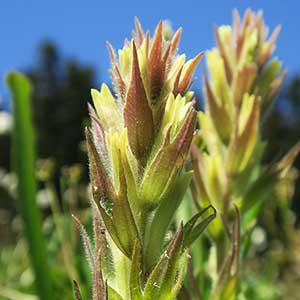Castilleja cryptantha
Castilleja purpurascens
Mt. Rainier or obscure paintbrush, obscure Indian paintbrush, obscure paintbrush
yoho paintbrush
few to several, erect or ascending, unbranched, hairs spreading, long, soft, eglandular, mixed with short stipitate-glandular ones.
few or several, ascending to erect, branched or unbranched, shiny proximally, glabrous proximally, hairy distally, hairs spreading, long, soft, eglandular, sometimes sparsely glandular.
green, often with brown or purple veins, narrowly to broadly lanceolate, 1.5–4 cm, not fleshy, margins plane, ± involute, 0–3-lobed, apex acute to acuminate;
lobes spreading-ascending, narrowly lanceolate, apex acute to ± obtuse.
deep purple to green, linear-lanceolate to narrowly lanceolate, rarely broadly lanceolate, 1.5–4.5 cm, not fleshy, margins plane, flat or slightly involute, 0(–3)-lobed, apex usually acuminate or acute;
lobes upright or ascending, lanceolate, apex acute.
(2.5–)3–6 × 1–2 cm; green to dull brown or dull reddish purple throughout, or proximally green to dull brown or dull reddish purple, distally yellow on apices, broadly lanceolate to ovate, (0–)3-lobed;
lobes ascending, narrowly lanceolate, long or short, arising near mid length, apex acute or acuminate.
2–12 × 2–6 cm;
bracts deep reddish or crimson, rarely magenta or dull orange, or proximally greenish near base, distally colored as above, oblong to broadly lanceolate, often spreading from base and exposing calyces, 0–3(–5)-lobed;
lobes ascending to erect, linear, short to medium length, arising near or above mid length, apex acute to obtuse.
straight, 14–16 mm;
tube 11–14 mm;
whole corolla included within calyx;
beak adaxially pale yellow, 1–2 mm;
abaxial lip deep green, slightly inflated, 4–5 mm, 67% as long as beak;
teeth ascending, pale, 1.5–2 mm.
straight to slightly curved, 20–37 mm;
tube 12–21 mm;
abaxial lip sometimes exserted, beak exserted;
beak adaxially green, 10–16 mm;
abaxial lip green, sometimes yellow, usually reduced, protruding through abaxial cleft, sometimes a little pouched, 3-lobed, 2–6 mm, 17–45% as long as beak;
teeth erect, green, whitish, or yellow, 1–1.5 mm.
proximally green or pale with green veins, lobes yellow, sometimes becoming deep red with age, 12–15 mm;
abaxial and adaxial clefts 3–7 mm, 25–50% of calyx length, deeper than laterals, lateral 1–3(–4) mm, 8–20% of calyx length;
lobes triangular, adaxial segments longer than abaxials, apex acute or obtuse.
colored as bracts, 18–28 mm;
abaxial clefts 5–6 mm, adaxial 8–15 mm, clefts 28–50% of calyx length, deeper than laterals, lateral 1.5–6 mm, 5–25% of calyx length;
lobes long-triangular, apex acute.
= 24.
= 48.
Castilleja cryptantha
Castilleja purpurascens
Castilleja cryptantha is endemic to the vicinity of Mt. Rainier in the Cascade Range, with most populations found within Mt. Rainier National Park. Unlike most species of Castilleja, it is apparently self-pollinating (W. J. Duffield 1972); the small flowers are entirely enclosed within the yellowish calyces, which tend to grow deep reddish as they age. The purplish brown bracts are also unusual in the genus.
(Discussion copyrighted by Flora of North America; reprinted with permission.)
Castilleja purpurascens is a species of gravelly flood plains and riverbanks at moderate elevations in the vicinity of the Kicking Horse River in Yoho National Park, British Columbia, and in immediately adjacent Alberta. While this tetraploid species may be derived from hybridization between C. miniata and C. rhexiifolia, its combination of traits is unique, and the species forms morphologically consistent populations limited to a habitat not particularly favored by either putative parent species. Very occasional hybrids are known with both C. lutescens and C. miniata.
(Discussion copyrighted by Flora of North America; reprinted with permission.)
- Local floras:
BC
- Local Web sites:
PNW Herbaria
WildflowerSearch
iNaturalist (observations)
- LBJ Wildflower Center
- SEINet
- Plants of the World Online
- Encyclopedia of Life
- Wikipedia
- Google Image Search


